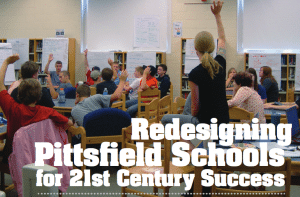Implementation Insights from Pittsfield School District
CompetencyWorks Blog
(This is the last of a four-part series on Pittsfield: See Part 1, Part 2 and Part 3.)
We are on a journey, and sometimes it’s a bumpy one. That’s a constant refrain when talking to districts converting from traditional curriculum/time-based systems to student-centered systems. Below are a handful of insights shared by the Pittsfield School District leadership team about their redesign process and the challenges they are encountering.
1. Community as Authentic Partner: Superintendent John Freeman explained that, “We took direction from the community about the kind of graduates they wanted and the type of school they wanted. As we began the high school redesign process, we have never backed off from engaging our community. Our community is in the driver’s seat.” Everyone we spoke with throughout the site visit reinforced the value that the broader community and students are partners. As PSD began implementation, they alerted their Community Advisory Council (now the Good to Great Team) as they hit implementation issues and engaged them in problem-solving around mid-course corrections.
2. Project Management: PSD says they couldn’t have done it without assigning staff to be the project managers. It’s just too much for district staff and principals to manage daily operations and the redesign process. Building project management capacity is more than dedicating staff – it’s also about building the capacity of the district to use project management tools such as process analysis. Even students are learning to create process analysis maps. Tobi Chassie, Co-Project Manger of the Systems Change Initiative, was grateful for the insistence of Nellie Mae Education Foundation, PSD invested in building out the districts project management capacity.
3. Beyond the Dip: We all know there is a dip at some point in the implementation process. Confusion is on the upswing and achievement scores may even go down. The question is, how fast can we get beyond the dip and embrace the new practices?
PSD spent a lot of time in preparation and design with a strong emphasis on engaging community in the core of their redesign efforts. They then did all the implementation of the redesign in one year. They said it was a really, really hard year – a year of “ripping off the Band-Aid.” But when they came back in September of the next school year, they knew they were over the hard part and felt good that they were all going in the same direction.
Tobi Chassie and Susan Bradley, Co-Project Manger of the Systems Change Initiative, said the advice of Joe DiMartino of the Center for Secondary School Redesign to build in a late start Wednesday for teachers to meet. Teachers used this time to work out kinks in implementation and manage their own professional development to improve their skills in student-centered learning.
4. Realizing Power School Can’t Power Up Personalized Learning: As all districts converting to personalized and/or competency education are finding, the student information system vendors are a barrier. They either aren’t up for or willing to modify their systems around student-centered learning. PSD has tried to get Power School to make the needed modifications, but so far they haven’t gotten what they wanted. So PSD is going forward with a report that they designed themselves to monitor student progress in courses but without the learning progressions that create the transparency to bring their personalized approach to the next level.
5. Redefining Role of Adults: The fourth of five elements of the PSD logic model is redefining role of adults. PSD took this seriously and analyzed each position in the district with a group of people, including community members asking what should adults’ role be in a student-centered learning environment. (See the post on Organizational Redesign for more information.) Updating job descriptions and organizational restructuring was just the beginning. PSD also is creating a teacher evaluation model based on the Danielson model, in which teachers present a portfolio of what they tried, what they learned, and where they are going next.
6. Safe to Take Risks: We know that to change we need to learn. And to learn means we are going to make mistakes. Just as competency-based schools need to make it safe for students to make mistakes, those districts converting to competency education need to create safe environments. That means the people with institutional power have to learn to use it to create room for innovation; that is what is happening in New Hampshire and Pittsfield. How can I tell? When asked about the degree of helpfulness or hindrance from NH’s Department of Education, the response was, “We love our commissioner. She understands what we are trying to do and supports us.” Similarly, educators from PSD repeatedly said that Superintendent Freeman walks the walk, role modeling how to engage others, take risks, and learn from mistakes.
